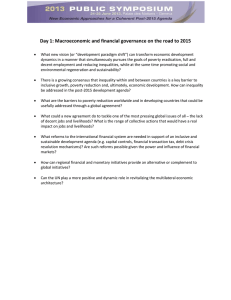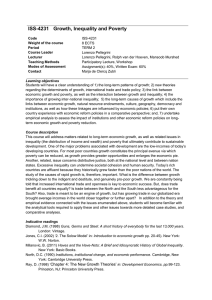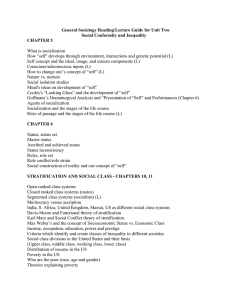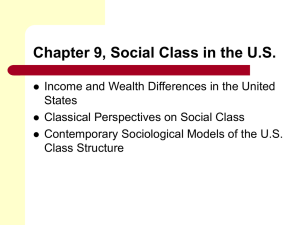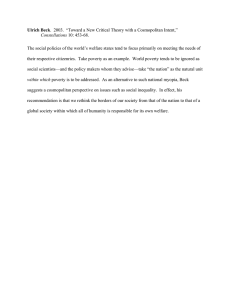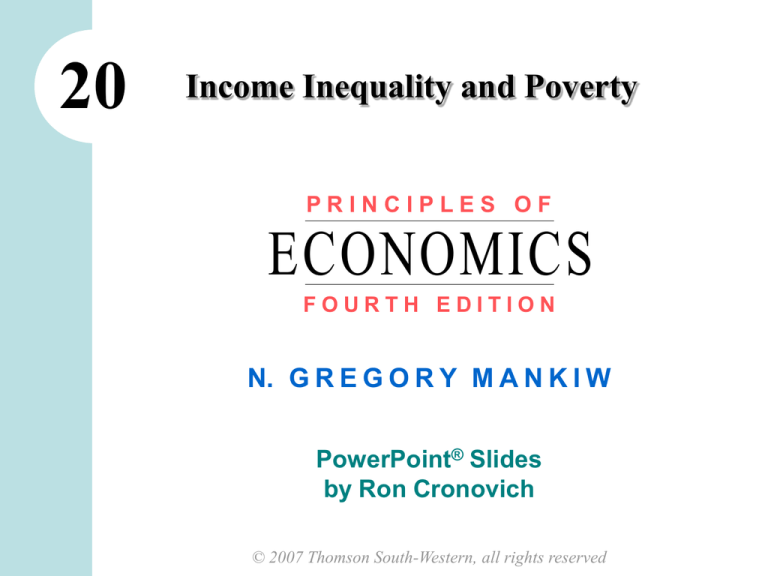
20
Income Inequality and Poverty
PRINCIPLES OF
ECONOMICS
FOURTH EDITION
N. G R E G O R Y M A N K I W
PowerPoint® Slides
by Ron Cronovich
© 2007 Thomson South-Western, all rights reserved
In this chapter, look for the answers to
these questions:
How much inequality and poverty exist in our
society?
What are the problems measuring inequality?
What are some of the leading philosophies
on the proper role of government in altering
the distribution of income?
What policies are used to fight poverty? What are
the problems with these policies?
CHAPTER 20
INCOME INEQUALITY AND POVERTY
1
Introduction
Recap of the previous two chapters:
• equilibrium wages equal the value of workers’
marginal products
• differences in equilibrium wages result from
differences in
• worker characteristics:
education, experience, talent, effort
• job characteristics:
extent to which a job is pleasant and safe
• some earnings differences due to discrimination
CHAPTER 20
INCOME INEQUALITY AND POVERTY
2
Introduction
Even in the absence of discrimination,
the income distribution in a market economy
may not be equitable or otherwise desirable.
In this chapter, we examine
• indicators of inequality and poverty
• philosophies about income redistribution
• policies designed to help the poor
CHAPTER 20
INCOME INEQUALITY AND POVERTY
3
The U.S. Income Distribution: 2003
Group
Annual family income
Bottom fifth
Under $24,117
Second fifth
$24,117 – $42,057
Middle fifth
$42,057 – $65,000
Fourth fifth
$65,000 – $98,200
Top fifth
$98,200 and over
Top 5 percent
$170,082 and over
CHAPTER 20
INCOME INEQUALITY AND POVERTY
4
U.S. Inequality Over Time
Income share of the top 20% divided
by income share of the bottom 20%
14
12
10
8
6
CHAPTER 20
INCOME INEQUALITY AND POVERTY
2000
1990
1980
1970
1960
1950
1940
1930
4
5
Inequality Around the World
South Africa
Brazil
Mexico
Nigeria
China
Russia
United States
United Kingdom
Canada
Income share of the top 20% divided
by income share of the bottom 20%
India
Germany
Japan
0
CHAPTER 20
5
10
15
20
25
INCOME INEQUALITY AND POVERTY
30
35
6
Poverty
Poverty line: an absolute level of income
set by the govt for each family size
below which a family is deemed to be in poverty
Poverty rate: the percentage of the population
whose family income falls below the poverty line
In 2003 in the U.S.,
• median family income = $52,680
• poverty line for family of four = $18,810
• poverty rate = 12.5%
CHAPTER 20
INCOME INEQUALITY AND POVERTY
7
U.S. Poverty Over Time
Percent of the population
below poverty line
CHAPTER 20
INCOME INEQUALITY AND POVERTY
8
U.S. Poverty Rate by Group, 2003
Group
All persons
CHAPTER 20
Poverty Rate
12.5%
White, not Hispanic
8.2
Black
24.4
Hispanic
22.5
Asian, Pacific Islander
11.8
Children
17.6
Elderly
10.2
Married-couple families
5.4
Female household,
no spouse present
28.0
INCOME INEQUALITY AND POVERTY
9
Problems Measuring Inequality
1. In-kind transfers: assistance that takes the form
of g&s rather than cash
• Omitted from measures of inequality and poverty,
biasing them upward
2. The Life Cycle: the regular pattern of
income variation over a person’s life
• People can borrow and save to offset life-cycle
changes in income (e.g., saving for retirement).
• Life-cycle income variation causes inequality in
income, but not inequality in living standards.
CHAPTER 20
INCOME INEQUALITY AND POVERTY
10
Problems Measuring Inequality
3. Transitory vs. Permanent Income:
• People can borrow and save to smooth out
transitory income fluctuations.
• A better measure of inequality in living standards
would be based not on current income, but on
permanent income, a person’s normal income.
4. Economic mobility:
• Many people move among income classes.
• The poverty and inequality measures
discussed above do not distinguish between
the temporarily poor and the persistently poor.
CHAPTER 20
INCOME INEQUALITY AND POVERTY
11
The Political Philosophy of
Redistributing Income
We consider three philosophies:
Utilitarianism
Liberalism
Libertarianism
CHAPTER 20
INCOME INEQUALITY AND POVERTY
12
Utilitarianism
Utility: a measure of happiness or satisfaction
Utilitarianism: argues that govt should choose
policies to maximize society’s total utility
• Founders: Jeremy Bentham, John Stuart Mill
Because of diminishing marginal utility,
redistributing income from rich to poor
increases utility of the poor more than it reduces
utility of the rich.
Yet, utilitarians do not advocate equalizing
incomes – would reduce total income of everyone
due to incentive effects and efficiency losses.
CHAPTER 20
INCOME INEQUALITY AND POVERTY
13
Liberalism
Liberalism: argues that govt should choose
policies deemed to be just by an impartial observer
behind a “veil of ignorance”
• Founder: John Rawls
Maximin criterion: govt should aim to maximize
the well-being of society’s worst-off person
Calls for more redistribution than utilitarianism
(though still not complete equalization of incomes).
Income redistribution is a form of social insurance,
a govt policy aimed at protecting people against the
risk of adverse events.
CHAPTER 20
INCOME INEQUALITY AND POVERTY
14
Libertarianism
Libertarianism: argues that govt should punish
crimes and enforce voluntary agreements but not
redistribute income
• Advocate: Robert Nozick
Instead of focusing on outcomes, libertarians focus
on the process.
• Govt should enforce individual rights,
should try to equalize opportunities.
• If the income distribution is achieved fairly,
govt should not interfere, even if unequal.
CHAPTER 20
INCOME INEQUALITY AND POVERTY
15
Policies to Reduce Poverty
Poor families more likely to experience
• homelessness
• drug dependence
• health problems
• teen pregnancy
• illiteracy
• unemployment
Most people believe govt should provide a
“safety net.”
We now consider a few such policies…
CHAPTER 20
INCOME INEQUALITY AND POVERTY
16
1. Minimum-Wage Laws
Arguments for:
• helps the poor without any cost to the govt
• little impact on employment if demand for
unskilled labor is relatively inelastic
Arguments against:
• In the long run, demand for unskilled labor is
•
likely elastic, so minimum wage causes
substantial unemployment among the unskilled.
Those helped by minimum wage are more likely
to be teens from middle-income families than
low-income adult workers.
CHAPTER 20
INCOME INEQUALITY AND POVERTY
17
2. Welfare
Welfare: govt programs that supplement the
incomes of the needy
• Temporary Assistance for Needy Families (TANF)
• Supplemental Security Income (SSI)
Critics argue that such programs create incentives
to become or remain needy, argue that welfare
contributed to the rise of the single-parent family.
However, the severity of such incentive problems
is unknown.
Proponents note that inflation-adjusted welfare
benefits fell as single-parent families increased.
CHAPTER 20
INCOME INEQUALITY AND POVERTY
18
3. Negative Income Tax
Negative income tax: a tax system that collects
revenue from high-income households and gives
transfers to low-income households
Example: Taxes owed = (1/3 of income) – $10,000
• If earnings = $90,000, taxes owed = $20,000
• If earnings = $60,000, taxes owed = $10,000
• If earnings = $30,000, taxes owed = $0
• If earnings = $15,000, taxes “owed” = –$5,000
i.e., would receive $5000 payment from govt
The Earned Income Tax Credit (EITC) is similar to a
negative income tax.
CHAPTER 20
INCOME INEQUALITY AND POVERTY
19
4. In-Kind Transfers
In-kind transfers are goods or services provided to
the needy. Examples:
• homeless shelters
• soup kitchens
• food stamps, govt vouchers redeemable
for food at grocery stores
• Medicaid, govt-provided healthcare for the poor
An alternative: cash payments
• would allow people to buy what they most need
• but critics argue could be used for drugs, alcohol
CHAPTER 20
INCOME INEQUALITY AND POVERTY
20
Anti-Poverty Programs and Work Incentives
Assistance from anti-poverty programs
declines as income rises.
The result: Poor families face high effective
marginal tax rates (exceeding even 100% in
some cases!).
Such policies therefore discourage the poor from
escaping poverty on their own.
One possible solution: “workfare,” a system
requiring people to accept government jobs
while collecting benefits.
CHAPTER 20
INCOME INEQUALITY AND POVERTY
21
CONCLUSION
Poverty is one of society’s most serious problems.
One of the Ten Principles from Chapter 1:
Governments can sometimes
improve market outcomes.
Public policy can help reduce poverty and
inequality.
Another principle: people face trade-offs.
Policies designed to improve equity
often sacrifice efficiency, so the proper scope of
policy is the subject of ongoing controversy.
CHAPTER 20
INCOME INEQUALITY AND POVERTY
22
CHAPTER SUMMARY
Data on income distribution show a wide disparity
in our society. The richest 20% of families earn
about ten times as much as the poorest 20%.
Problems in measuring inequality arise from
in-kind transfers, the economic life cycle,
transitory income, and economic mobility.
When these factors are taken into account,
the distribution of well-being is probably less
unequal than the distribution of annual income.
CHAPTER 20
INCOME INEQUALITY AND POVERTY
23
CHAPTER SUMMARY
Political philosophers differ in their views of the
proper role of government in altering the income
distribution. Utilitarians believe that income
distribution should maximize the sum of
everyone’s utility. Liberals believe the government
should aim to maximize the well-being of the
worst-off person in society. Libertarians believe
the government should aim for equality of
opportunity, not equality of income.
CHAPTER 20
INCOME INEQUALITY AND POVERTY
24
CHAPTER SUMMARY
Policies such as welfare, minimum-wage laws,
negative income taxes, and in-kind transfers can
help the poor.
Since financial assistance falls as income rises,
the poor face high effective marginal tax rates,
discouraging them from escaping poverty on their
own.
CHAPTER 20
INCOME INEQUALITY AND POVERTY
25

